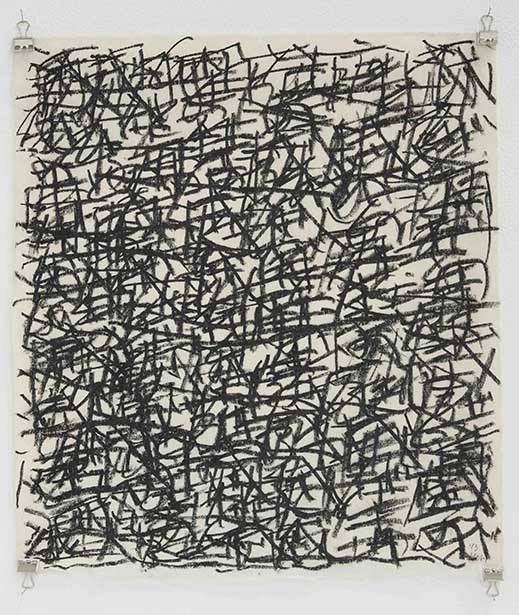|
To Remember - The Sea of Mabuni, Okinawa 2013 (2014); charcoal on print, 110 x 220 cm. © Kosai Hori; photo by Kei Miyajima |
Kosai Hori has been a noted presence on the contemporary Japanese art scene since the early 1970s, when, as a member of the Artists Joint-Struggle Council (Bikyoto), he was associated with the Anti-Art movement and the creative sturm und drang unleashed by student protests and other social upheavals of the day. He was known for dramatic body-art performances both on the street and on the stage, many of which featured Hori writhing around, clad only in coils of rope that wrapped him from head to toe.
In recent years Hori's work has acquired qualities of depth and lyricism that give it a new accessibility, even as it continues to challenge conventional assumptions about art. He seems especially interested in dismantling the boundary between image and text, citing Japanese calligraphy as an art form that blends both. Many of his compositions today are covered with a dense mesh of scrawled lines that derive from but go beyond the written word. The predominance of linear strokes gives these works a passing resemblance to those of Cy Twombly, but Hori is much more of a "message" artist, as is clear from the series he is now showing at Tokyo's Mizuma Art Gallery until July 4.
|
The Garden of the Fall and Rebirth-13 (2015); Japanese ink, mineral pigments, dermatograph, charcoal, crayon, oil pastel, silver leaf on canvas, 333.3 x 248.5 cm. © Kosai Hori; photo by Kei Miyajima |
Hori was not alone in being profoundly affected by the earthquake, tsunami, and nuclear disasters of March 2011. Few other veteran artists, however, have placed their decades of experience and experimentation at the service of this theme with such devotion. Last year Hori published a massive tome, Horobi to Saisei no Niwa (The Garden of the Fall and Rebirth), in which he set down his thoughts after a visit to the tsunami-stricken Miyagi coast. Much of his new work -- and indeed, the very process by which he creates it -- extrapolates from that material.
|
The Garden of the Fall and Rebirth-14 (2015); Japanese ink, mineral pigments, dermatograph, charcoal, oil pastel, silver leaf on canvas, 130.3 x 162 cm. © Kosai Hori; photo by Kei Miyajima |
Bearing the book's title, which Hori acknowledges is a reference to the biblical story of humanity's primordial loss of innocence, the Mizuma show features works of various dimensions created by the artist at his studio while his wife sat nearby and read excerpts of his writings aloud. Taking the words as his cue, Hori began by scribbling on the canvas with charcoal, grease pencil, or other materials. As the reading progressed, however, his writing would grow increasingly abstract until it no longer resembled text. As Hori describes it, the spoken words would pass from his ear to his brain, and then to his hand, but over time the transmission of meaning would break down, transmuting the text into lines of "noise." It is this "noise" that he committed to the canvas, in a gesture that he likens to inflicting a wound.
 |
|
The Garden of the Fall and Rebirth (2013); dermatograph, Japanese paper, 38 x 34 cm. © Kosai Hori; photo by Kei Miyajima |
In some of the works in the "Garden" series, like the relatively compact and simple The Garden of the Fall and Rebirth (2013), the characters of the Japanese title, horobi to saisei no niwa, are clearly visible, in part because they are written on plain white paper devoid of background interference. But it is the more monumental works, in which Hori has drawn his lines over an existing painting -- or in the case of To Remember - The Sea of Mabuni, Okinawa 2013, over a photograph -- that most fully realize the potential for powerful emotional interaction between text and image. Though the images in question are nearly abstract, as well as obscured by the fog of lines, they are in fact pictures that Hori took, or painted, of the ocean. The "Garden" paintings show the Pacific beyond the tsunami-devastated town of Yuriage -- what Hori has described as "a peaceful sea stretching out on the horizon. It seemed impossible that this very sea had claimed so many lives and homes." The sea at Mabuni, on the other hand, is where Okinawans threw themselves off the cliffs amid the most horrific battle of the Pacific War, after U.S. forces landed on their island in 1945. Hori has overwritten this lovely shot of a wave-washed shore with dense iterations of the phrase kioku suru tame ni -- "to remember."
The frantic intensity of Hori's tapestry of lines readily conjures up the association he makes with inflicted wounds. But he also describes the act of drawing as something like "taking a deep breath." It is at once noise, and a prayer. As a gesture of remembrance, it resonates at a level far deeper than words.
View of the Kosai Hori exhibition at Mizuma Art Gallery. Photo by Kei Miyajima
All images are courtesy of Mizuma Art Gallery. |
 |
|
| |
2F Kagura Bldg., 3-13 Ichigaya-tamachi, Shinjuku-ku, Tokyo
Phone: 03-3268-2500
Hours: 11 a.m. - 7 p.m.
Closed Sundays, Mondays, and national holidays
Access: 5 minutes' walk from Tokyo Metro Ichigaya Station, exit 5 (Yurakucho and Nanboku Lines); 8 minutes' walk from JR Iidabashi Station, west exit (Sobu Line) |
|
|
| |
 |
Alan Gleason
Alan Gleason is a translator, editor and writer based in Tokyo, where he has lived for 30 years. In addition to writing about the Japanese art scene he has edited and translated works on Japanese theater (from kabuki to the avant-garde) and music (both traditional and contemporary). |
|
|
|
|